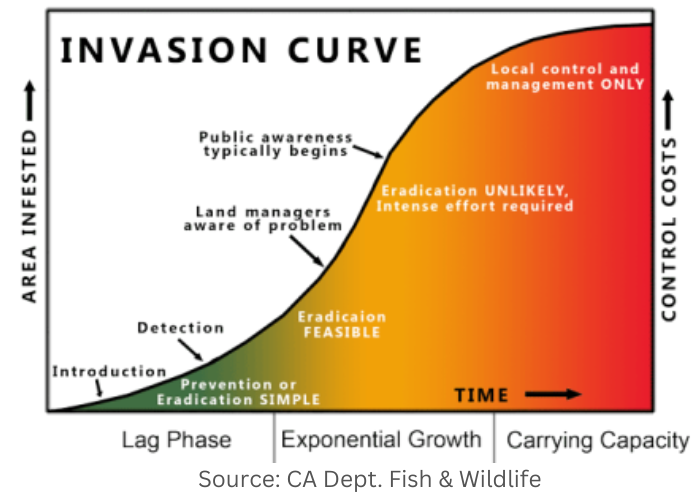Invading Invasives
Protected No More
For hundreds of thousands of years, California evolved as a unique ecosystem protected by the Pacific Ocean on one side and multiple mountain ranges and deserts on all other sides. Other than migrating birds and some adaptive mammals, these same barriers made it difficult for indigenous peoples and early explorers to spread new, potentially invasive organisms into the state.
As ocean voyagers, horses, trains, roads and air travel opened up the pathways into the Golden State, California has had a long running battle with non-native species of plants, insects, animals and diseases being introduced into the state unintentionally, intentionally and ignorantly over centuries. Unintentionally, the tumbleweed (seeds) travelled from Eastern Europe with immigrants during the Gold Rush. Citrus, grapes and olives were intentionally introduced by the early Spanish missionaries…and with them come accidental introductions of fruit flies and other damaging insects pests.
Today’s Constant Challenge
Today, the constant challenge for both the food supply and the environment comes from a barely controlled flow of invasive species that, if given the chance, will become invading pests, nuisances and dominant species, crowding out others. The difference between invasive species and an invading species is subtle but easy to describe. Non-native invasive species often have no natural enemies and can multiply quickly without a check and balance from nature or…government.
Focus, Vigilance and Support
The incredibly important County Agricultural Commissioners, working together with the CA Dept of Food and Agriculture, USDA and Homeland Security are the main line of defense for stopping invasive pests and diseases. Prevention, exclusion, detection, eradication and mitigation are the progressive disciplines that need to be in place if we are to protect our food supply and the environment.
While all gardeners understand that invading pests like grasshoppers, snails, slugs, aphids, squirrels, rabbits, rats, and ants are regularly competing for our food supply, some of the greatest threats to humanity are from uncontrolled introductions of potential invasive pests that can cause catastrophic problems. Destructive forest diseases and desert weed invasives open the door for wildfires, while animal to human ‘zoonotic’ diseases like West Nile Virus, Lyme Disease or Avian Influenza can affect our domesticated animals and…us. Most recently, California is dealing with an unprecedented infestation of invasive exotic fruit flies that threaten our fruit industry. Recognizing that “Invasive Species Know No Borders”, all of these vulnerabilities in a complex world require a keen focus, vigilance, support…and understanding from the public. So look for messages on keeping up our guard…It’s a lesson we hate to re-learn.


